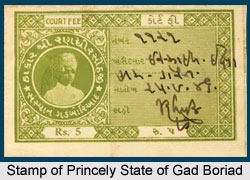 The Princely State of Gad Boriad was amongst the princely states of India during the rule of the British Empire in India. During the early 19th century, the region was appointed as one of the princely states under the indirect rule of the British administration. The region was extended over a total area of 128 sq miles and comprised of a total population of 10,940 in the year 1941. The territory of Gad Boriad was one of the 27 states which formed up the Sankheda Mehvassi, located on the banks of the Narbada (Narmada) River, in eastern Gujarat. Along with the state of Khaseda and 9 other bhayati estates, it was the largest amongst the states in the Sankheda Mehvassi. It was incorporated as a part of the erstwhile Rewa Kantha Agency.
The Princely State of Gad Boriad was amongst the princely states of India during the rule of the British Empire in India. During the early 19th century, the region was appointed as one of the princely states under the indirect rule of the British administration. The region was extended over a total area of 128 sq miles and comprised of a total population of 10,940 in the year 1941. The territory of Gad Boriad was one of the 27 states which formed up the Sankheda Mehvassi, located on the banks of the Narbada (Narmada) River, in eastern Gujarat. Along with the state of Khaseda and 9 other bhayati estates, it was the largest amongst the states in the Sankheda Mehvassi. It was incorporated as a part of the erstwhile Rewa Kantha Agency.
Location of Princely State of Gad Boriad
The princely state of Gad Boriad consisted of only a single large block of territory that was located towards the eastern portion of the Sankheda Mehvassi. Gad Boriad state was bounded by the princely state of Chhota Udepur, princely state of Baroda and the princely state of Baroda in the north; by the princely states of Baroda, Vasan Virpur, Chhota Udepur and the native state of Rajpipla in the west; by the territory of Chhota Udepur in the east; and by British India in the south.
History of Princely State of Gad Boriad
The Chauhan Rajputs, a cadet branch of the ruling family of the state of Chhota Udepur, acted as the ruling family of the princely state of Gad Boriad. The native rulers of the princely state of Gad Boriad held the title of Thakor. Later the state came under the protection of the British East India Company and was assigned as a native state. The succession of the throne or gadi of the state was governed by the rule of male primogeniture, by which the first born or eldest child of the same parents inherited the entire estate of one or both parents, to the exclusion of all others.
Administration of Princely State of Gad Boriad
The native state was under the administrative control of the Baroda Agency, which was incorporated as a part of the Western India States Agency. Later the territory was merged with the state of Gujarat. Until the abolition of class system in the year 1928, the Princely State of Gad Boriad was a jurisdictionary state of the sixth class. The Thakor of the state supervised the administration of the state and exercised limited civil and criminal jurisdiction and powers of law enforcement, even over the ten bhayati estates of Bharwada, Raipur, Ratanpura, Jeher, Kodha, Sengpur, Khichadia, Chorawal, Bhaka and Khaseda. The Political Agent, also known as Resident of British India, supervised the relations of the native ruler and the state with the British administration and other Indian princely states.
The native rulers who exercised jurisdictional authority were formally addressed as Meherban. The native state of paid did not pay any annual tribute to the British authorities or any other princely states. However the Durbar and the 10 bhayati estates paid fees to the princely state of Chhota Udepur. According to the Attachment Scheme of 1943, the princely state of Gad Boriad was attached to Chhota Udepur state in the year 1943.
Accession of Princely State of Gad Boriad
The last native ruler of the princely state of Gad Boriad acceded the princely state to the Dominion of India, also known as Union of India, after the country gained independence from the British Supremacy in the year 1947. Later the region was incorporated as a part of the Indian state of Gujarat.



















